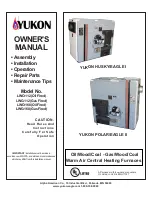
Hamilton
Home
Products
Canal
Winchester,
OH
76106
61MH0028A
Page
13
SECTION IX: THERMOSTAT WIRING AND
CONNECTIONS
Thermostat Wiring
Thermostat wires connect through side of furnace and should
be no smaller than 24 gauge. Refer to Table 11 for
recommended wire gauge, lengths and maximum current for
each wire gauge.
Maximum
Wire Length
Thermostat
Wire Gauge
Thermostat Wire
Maximum Current
0 - 112 Feet
18
3.0 Amps
0 - 70 Feet
20
3.0 Amps
0 - 30 Feet
22
3.0 Amps
Table 11: Low Voltage Wire Gauge and Max Lengths
NOTE:
There is a 3 Amp slow blow bar fuse located in the
control box that protects the 24 VAC circuit. Replace this fuse
only with the equivalent 3 Amp fuse.
Power wires can enter through the side of the unit or through
the auxiliary entrance, located in the bottom of the unit.
When bringing wiring through the bottom of the furnace,
cable connectors must be installed to hold wiring in place and
to relieve any strain on the wiring.
These connectors will also serve as a seal between the furnace
and the floor. Thus, additional sealing is not required.
The use of a five-conductor cable from the thermostat to the
furnace is recommended for typical heating or heating/cooling
installations with a two or three-conductor cable from the
furnace to the condenser. The thermostat wire colors and the
typical heating/cooling connections are listed in Tables 12 and
13.
A seven-conductor cable from the thermostat to the furnace is
recommended for a typical heat pump installation with a five-
conductor cable from the furnace to the condenser.
The thermostat wire colors and the typical heat pump
heating/cooling connections are listed in Tables 12 and 13.
NOTE:
If the thermostat cable is on the left side of the
furnace move the grommet in the 3/8” hole on the left side of
the furnace casing to the 3/8” hole on the right side of the
furnace casing. Run the thermostat wire cable through the
control box to the low voltage control box. Place the
thermostat wire next to the low voltage terminal block. Attach
the strain relief to the control box. Do not attach the strain
relief to the furnace casing because the sheet metal is too thin.
Figure 15: Control Box Power, Low voltage wire
Locations
Thermostat Installation
The thermostat heat anticipator must be-set at 0.7 Amps if the
thermostat has a manual heat anticipator adjustment. This
setting should be checked at the time of installation.
The thermostat may be a “self-setting" type in which case no
heat anticipator setting will be found on the thermostat,
eliminating the need for any field adjustment.
Thermostat should be located on an inside wall in an open area
to more closely regulate average room air, preferably, where
there is air movement back to furnace. Locating height of
thermostat is important. Thermostat should be located
preferably in a hall way upstream from the furnace return
airflow, not within three feet of from any windows and 52 to
66 inches above the floor.
DO NOT
place the thermostat within three feet of any of the
furnace supply air registers
DO NOT
place the thermostat within three feet of any of the
air conditioner supply air registers
Maintenance, operating and/or programming instructions are
in the envelope accompanying the thermostat. Give the
envelope to the home owner.
Separate Heating and Cooling System; Same Thermostat
If the furnace and the cooling unit have separate transformers
be sure to use a thermostat with isolated heating and cooling
contacts “RC” and “RH” to prevent interconnection of Class II
24 Volt Systems Refer to Figures 18 and 19. Cycle furnace
and the air conditioner separately to make sure it will operate
correctly.
Most new thermostats have separate heating and cooling
contacts for use with homes that have a furnace and air
conditioner that are completely separate and each have a 24
VAC transformer for system control. These thermostats have a
“RC” terminal for cooling and a “RH” terminal for heating.
Connect the cooling unit red wire from the “R” terminal on the
outdoor unit to the “RC” terminal on the thermostat and the
RED furnace pigtail wire to the “RH” terminal on the
thermostat. Refer to Figures 18 and 19 for typical low voltage
wire connections.
Do not locate thermostat within three feet of any of the
following items:
1
Furnace supply air registers
2
Cooling unit supply air registers
3
Lights or heat lamps
4
Aquariums
5
Televisions, stereo, amplifiers, surround sound systems
6
Stoves or any cooking appliance
7
Refrigerator
8
Washer and/or dryer
9
Hot water tank
10
Sink or near any hot water
11
Within 15 feet of any electric space heater
12
Within two feet of any sunlight



































